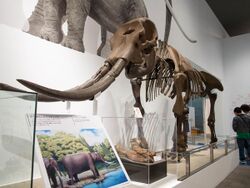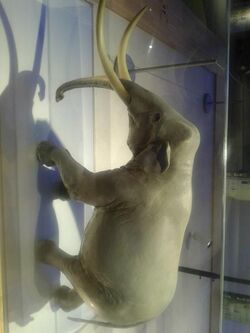Biology:Stegodon aurorae
| Stegodon aurorae Temporal range: Plio-Pleistocene
| |
|---|---|

| |
| Replica of the well-preserved Akebono elephant skeleton from Taga, Shiga Prefecture (Mie Prefectural Museum) | |

| |
| Model of Stegodon aurorae | |
| Scientific classification | |
| Domain: | Eukaryota |
| Kingdom: | Animalia |
| Phylum: | Chordata |
| Class: | Mammalia |
| Order: | Proboscidea |
| Family: | †Stegodontidae |
| Genus: | †Stegodon |
| Species: | †S. aurorae
|
| Binomial name | |
| †Stegodon aurorae (Matsumoto, 1918)[1]
| |
| Synonyms | |
Stegodon aurorae, also known as the Akebono elephant (アケボノゾウ Akebono-zō),[7] is a species of fossil elephantoid known from Early Pleistocene (2.0 Ma – 1.0 Ma) Japan and Taiwan.[8][9]:487
Description
The best-preserved Stegodon aurorae skeleton, that from Taga in Shiga Prefecture, stands to a shoulder height of 1.93 m (6 ft 4 in), with a body length of 4.58 m (15.0 ft).[10]:43 It is relatively short-legged, the ratio between vertebral column length and shoulder height being 0.88.[10]:43 The body mass of S. aurorae has been calculated at one quarter of that of its mainland ancestor S. zdanskyi, which had a shoulder height of around 3.6 m (12 ft);[11]:1658 as such, it is an example of insular dwarfism.[11]:1657
Distribution
Remains of Stegodon aurorae have been found in over forty-five localities in the Japanese archipelago, mainly in central Honshū.[10]:43 The type specimen was from Ishikawa Prefecture,[1] while among the eight skeletons, one was found in Saitama Prefecture, two in Nagano Prefecture, one in Shiga Prefecture, one in Mie Prefecture, and three in Hyōgo Prefecture.[12]:202 A fragmentary lower jaw with part of a third molar has also been recovered from "Cho-chen", Taiwan.[13]:31
Biozone
The species lends its name to the biostratigraphic assemblage zone referred to as the "S. aurorae Zone".[9]:487 This biozone, from two to one million years ago,[9]:487 includes deer (Elaphurus spp., Cervus sp.) and rhino (Rhinoceros sp.) as species that competed for resources, as well as the predator Falconer's wolf (Canis falconeri).[11]:1662
Faunal succession
Proboscidean fossils have been recovered from over three hundred and fifty sites in Japan.[8]:149 In accordance with the principle of faunal succession, the following sequence has been established: Gomphotherium annectens,[14]:318 Stegolophodon pseudolatidens,[14]:322 Sinomastodon sendaicus, Stegodon miensis, S. protoaurorae, S. aurorae, Mammuthus trogontherii, S. orientalis, Palaeoloxodon naumanni, and M. primigenius.[8]:149[15][9]:471
Speciation
Cladistic analysis of cranial characters suggests a close relationship between Stegodon aurorae and Stegodon zdanskyi from northern China.[10]:41 S. zdanskyi are thought to have reached Japan over a land bridge in the Early Pliocene, giving rise there to the smaller S. miensis, the earliest of the four stegodontids found in the Japanese archipelago, after isolation from the mainland due to the receding ice.[10]:41[9]:482[16] The "biostratigraphical gap" between S. miensis (c. 4–2.9 Ma) and S. aurorae (c. 2–1 Ma) is filled by S. protoaurorae (c. 2.9–2 Ma),[9]:487 its speciation perhaps "triggered" by marine transgression,[9]:484 with successive decreases in size an "evolutionary trend".[9]:488 The absence of S. aurorae from the fossil record of China and the Korean Peninsula supports the theory of the species arising within the archipelago.[17]:261
Taxonomy
Elephas aurorae was described by Matsumoto Hikoshichirō in 1918, based on an upper molar from Mount Tomuro in the old Province of Kaga (present-day Ishikawa Prefecture).[1] In 1924, Matsumoto erected the genus Parastegodon and transferred to it the Akebono elephant, the new combination being Parastegodon aurorae.[2] In 1938, Makiyama Jirō synonymized Parastegodon with Stegodon.[18]:15 In a 1991 review of the former genus Parastegodon, Taruno Hiroyuki confirmed the synonymization of Stegodon kwantoensis (Tokunaga, 1934), Stegodon sugiyamai (Tokunaga, 1935), Stegodon akashiensis (Takai, 1936), and Stegodon infrequens (Shikama, 1937), as well as some of the material referred to Stegodon shodoensis Matsumoto, 1924, with Stegodon aurorae.[19]
Stegodon orientalis shodoensis was described by Matsumoto in 1924, from material from the village of Yoshima [ja] (now Sakaide), Kagawa Prefecture.[20]:333 The subspecies was elevated to species rank by Makiyama in 1938.[18]:17 Some of the material referred to S. shodoensis (ショウドゾウ also ミツゴゾウ) belongs to S. aurorae.[19]:5 Parastegodon? kwantoensis, the protonym of Stegodon kwantoensis (カントウゾウ), was described by Tokunaga Shigeyasu in 1934 from dental material excavated in the village of Kakio [ja] (now Kawasaki), Kanagawa Prefecture.[5]:17 Parastegodon sugiyamai, the protonym of Stegodon sugiyamai (スギヤマゾウ), was described by Tokunaga Shigeyasu in 1935, from a molar unearthed during the building of a road in the village of "Saida", Kagawa Prefecture.[6] Parastegodon akashiensis, the protonym of Stegodon akashiensis (アカシゾウ), was described by Takai Fuyuji in 1936, from an upper molar (a cheek tooth) from the cliffs along the shore of the village of Ōkubo (now Akashi), Hyōgo Prefecture.[3] Additional material from the coast of and sea bed off Akashi, including two skulls and a lower jaw, was published at the same time and referred to P. akashiensis by Shikama Tokio.[21] Parastegodon infrequens, the protonym of Stegodon infrequens (インフリークエンスゾウ also タキガワゾウ), was described by Shikama Tokio in 1937, from material from the seabed off Akashi, Hyōgo Prefecture.[4][19]:12 P. kwantoensis, P. sugiyamai, and some of the material referred to P. akashiensis were synonymized with P. aurorae, and P. infrequens with P. akashiensis, by Takai in 1938.[22]:753–4 Taruno synonymized P. akashiensis with S. aurorae in 1991.[19]:5
See also
- List of prehistoric mammals of Japan
- National Museum of Nature and Science
References
- ↑ Jump up to: 1.0 1.1 1.2 1.3 Matsumoto Hikoshichirō (1918). "On a New Archetypal Fossil Elephant from Mt. Tomuro, Kaga". Science Reports of the Tohoku University. Second Series, Geology 3 (2): 51–56. ISSN 0082-464X.
- ↑ Jump up to: 2.0 2.1 Matsumoto Hikoshichirō (1924). (in ja)Journal of the Geological Society of Tokyo 31 (371): 255–272. doi:10.5575/geosoc.31.371_255.
- ↑ Jump up to: 3.0 3.1 3.2 Takai Fuyuji 高井冬二 (1936). "On a New Fossil Elephant from Okubo-mura, Akashi-gun, Hyogo Prefecture, Japan". Proceedings of the Imperial Academy 12 (1): 19–21. doi:10.2183/pjab1912.12.19.
- ↑ Jump up to: 4.0 4.1 Shikama Tokio (1937). "Parastegodon infrequens sp. nov. from the Akashi district". Japanese Journal of Geology and Geography 14 (3–4): 127–131.
- ↑ Jump up to: 5.0 5.1 Tokunaga Shigeyasu (1934). (in ja)Journal of Geography (Chigaku Zasshi) 46 (8): 363–371. doi:10.5026/jgeography.46.363.
- ↑ Jump up to: 6.0 6.1 Tokunaga Shigeyasu (1935). "A New Fossil Elephant Found in Shikoku, Japan". Proceedings of the Imperial Academy 11 (10): 432–434. doi:10.2183/pjab1912.11.432.
- ↑ "Geological History – Exhibition Room A". Lake Biwa Museum. https://www.biwahaku.jp/english/exhibits/room_a.html.
- ↑ Jump up to: 8.0 8.1 8.2 Takahashi, K.; Chang, C.H.; Cheng, Y.N. (2001). "Proboscidean fossils from the Japanese Archipelago and Taiwan Islands and their relationship with the Chinese mainland". The World of Elephants. Rome: Consiglio Nazionale delle Ricerche. pp. 148–151. ISBN 88-8080-025-6. https://sovraintendenzaroma.it/sites/default/files/storage/original/application/1b999d5a26659c7d92d5b580e40c0c82.pdf.
- ↑ Jump up to: 9.0 9.1 9.2 9.3 9.4 9.5 9.6 9.7 Aiba, H.; Baba, K.; Matsukawa, M. (2010). "A new species of Stegodon (Mammalia, Proboscidea) from the Kazusa Group (lower Pleistocene), Hachioji City, Tokyo, Japan and its evolutionary morphodynamics". Palaeontology 53 (3): 471–490. doi:10.1111/j.1475-4983.2010.00953.x.
- ↑ Jump up to: 10.0 10.1 10.2 10.3 10.4 Saegusa Haruo; Thasod, Yupa; Ratanasthien, Benjavun (2005). "Notes on Asian stegodontids". Quaternary International 126–128: 31–48. doi:10.1016/j.quaint.2004.04.013. https://www.researchgate.net/publication/222985624.
- ↑ Jump up to: 11.0 11.1 11.2 Geer, A.A.E. van der et al. (2016). "The effect of area and isolation on insular dwarf proboscideans". Journal of Biogeography 43 (8): 1656–1666. doi:10.1111/jbi.12743. https://www.academia.edu/27262337.
- ↑ 北御牧村アケボノゾウ発掘調査団 (2002). Kitamimakimura Akebonozou Excavation Research Group. ed. "Uncommon occurrence of Stegodon aurorae (Matsumoto) (Mammalia; Proboscidea) from Kitamimaki-mura, Nagano Prefecture, Japan". Earth Science (Chikyū Kagaku) 56 (3): 197–202. doi:10.15080/agcjchikyukagaku.56.3_197. ISSN 0366-6611.
- ↑ Shikama Tokio; Ōtsuka Hiroyuki 大塚裕之; Tomida Yukimitsu (1975). "Fossil Proboscidea from Taiwan (I)". Science Reports of the Yokohama National University. Section II, Biological and Geological Sciences 22: 13–62. doi:10.15080/agcjchikyukagaku.54.4_257. https://www.researchgate.net/publication/36424528.
- ↑ Jump up to: 14.0 14.1 Tomida Yukimitsu; Nakaya Hideo; Saegusa Haruo; Miyata Kazunori; Fukuichi Akira (2013). "Miocene Land Mammals and Stratigraphy of Japan". Fossil Mammals of Asia: Neogene Biostratigraphy and Chronology. New York: Columbia University Press. pp. 314–333. doi:10.7312/columbia/9780231150125.003.0012. ISBN 978-0-231-15012-5. https://www.researchgate.net/publication/344591601.
- ↑ Taru, H. 樽創; Kohno, N. 甲能直樹 (2002). Memoirs of the National Science Museum, Tokyo 38 (38): 33–41. https://cir.nii.ac.jp/crid/1572543024706402176.
- ↑ Taruno Hiroyuki (2010). "The stages of land bridge formation between the Japanese Islands and the continent on the basis of faunal succession" (in ja,en). The Quaternary Research (Daiyonki Kenkyū) 49 (5): 309–314. doi:10.4116/jaqua.49.309.
- ↑ Takahashi Keiichi; Namatsu Keiko (2000). "Origin of the Japanese Proboscidea in the Plio-Pleistocene". Earth Science (Chikyū Kagaku) 54 (4): 257–267. doi:10.15080/agcjchikyukagaku.54.4_257.
- ↑ Jump up to: 18.0 18.1 Makiyama Jirō (1938). Memoirs of the College of Science, Kyoto Imperial University. Series B 14 (1): 1–59. ISSN 0368-8895.
- ↑ Jump up to: 19.0 19.1 19.2 19.3 Taruno Hiroyuki 樽野博幸 (1991). (in en,ja)Bulletin of the Osaka Museum of Natural History 45: 5–16. http://id.nii.ac.jp/1504/00000253/.
- ↑ Matsumoto Hikoshichirō (1924). (in ja)Journal of the Geological Society of Japan 31 (373): 323–340. doi:10.5575/geosoc.31.373_323.
- ↑ Shikama Tokio (1936). "Note on Parastegodon akashiensis Takai from the Akasi District". Proceedings of the Imperial Academy 12 (1): 22–24. doi:10.2183/pjab1912.12.22.
- ↑ Takai Fuyuji 高井冬二 (1938). (in ja)Journal of the Geological Society of Japan 45 (541): 745–763. doi:10.5575/geosoc.45.745.
Wikidata ☰ Q11283098 entry
 |


